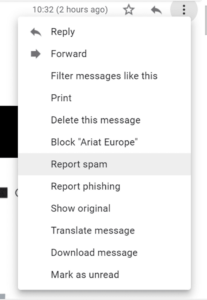
“Miért nem lesznek kézbesítve a hírleveleim?”
Megalkothatod a világ legtökéletesebb, legmeggyőzőbb e-mailmarketing kampányát – de az teljes kudarcot vall, ha senki sem látja.
A kampányod kézbesíthetősége – azaz annak esélye, hogy elérje a megfelelő közönséget – nagymértékben függ a küldői reputációdtól. Ezt a küldői reputációt az internetszolgáltatók (ISP-k, például Gmail, Outlook, Yahoo) határozzák meg a korábbi küldési szokásaid alapján. Ha a múltban spamszerű, megtévesztő vagy egyszerűen csak unalmas tartalmat küldtél, az ISP-k megvédik az ügyfeleiket azzal, hogy csökkentik a küldői hírnevedet. Ez jelentősen megnehezíti, hogy elérd a beérkező levelek mappáját.
Ha azonban magas színvonalú, érdekes tartalmat küldtél, amit a címzettek szeretnek, a küldői hírneved emelkedik, és minden alkalommal a beérkező mappába kerülnek az e-mailjeid. A kézbesíthetőségnek technikai feltételei is vannak. A megfelelő hírlevélküldő rendszer használata nélkül jelentősen csökken annak esélye, hogy hírleveleid elérjék az inboxot.
Hogyan érheted el a megfelelő küldői repurációt?

1 – Légy látható (Be seen)
Ha az elköteleződési mutatóid, például az átkattintási arány (CTR) csökkennek, annak az oka lehet, hogy senki sem látja az e-mailjeidet. Miért? Ennek az alábbi okai lehetnek:
- Visszapattanási arányok
Kétféle e-mail visszapattanás létezik: „kemény” (hard) és „puha” (soft). A „puha” visszapattanások miatt általában nem kell aggódni, hacsak nem ismétlődnek rendszeresen. A „kemény” visszapattanások viszont komolyabb problémát jelentenek. Ha sok ilyen fordul elő, az internetszolgáltatók (ISP-k) azt feltételezik, hogy nem tartod tisztán a címlistádat. Ez az, amit az ISP-k kifejezetten nem szeretnek. - Spamjelentések
Az internetszolgáltatók általában megengednek némi hibahatárt. Tudják, hogy néhány spamjelentés elkerülhetetlen, amikor promóciós tartalmat küldesz. Azonban, ha túl sok spamjelentést kapsz, az ISP-k habozás nélkül tönkreteszik a küldői hírnevedet.

- Feketelisták
Több száz feketelista létezik, de csak néhány jelentős számít igazán. Ezek például:- CBL (Composite Blocking List)
- SBL (Spamhaus Block List)
- XBL (Exploits Block List)
- Spamcop
- PSBL (Passive Spam Block List)
- Invaluement
- Barracuda
- Senderscore
Olyan eszközök, mint az MXtoolbox, segítenek megállapítani, hogy rajta vagy-e valamelyik releváns feketelistán. Ha igen, egyszerűen küldj üzenetet a lista tulajdonosának, és magyarázd el a helyzetet.
2 – Nyitásra ösztönzés (Be opened)
Ha a küldői reputációddal minden rendben van, de az elköteleződési arányaid még mindig alacsonyak, ideje elfogadni egy kemény igazságot: az ügyfeleid egyszerűen nem érdeklődnek eléggé a tartalmad iránt.
Ne aggódj – a legjobbakkal is előfordul! Ideje optimalizálni:
Szegmentálás és automatizálás
Ha lehetetlen feladatnak tűnik minden ügyfél tárgysorát személyre szabni, az azért van, mert kézzel valóban lehetetlen.
De automatizálással semmi sem lehetetlen. Csak a megfelelő adatokat kell a megfelelő módon bemutatni.
Ha rendelkezel adatokkal az ügyfeleid életkoráról, nevéről, lakóhelyéről, érdeklődési köreiről, preferenciáiról és így tovább, az automatizálás könnyedén képes ezeket az adatokat feldolgozni és alkalmazni.
Neked csak annyi a dolgod, hogy az ügyféllistádat releváns adatpontok alapján szegmentáld, készíts sablonokat minden szegmenshez, és a többit bízd a gépekre.
Például, ha a tárgysort a lakóhely szerint szeretnéd személyre szabni, először a listádat az ügyfelek lakóhelye alapján kell szétválogatnod. Így lehet, hogy lesz egy New York-i és egy londoni ügyfélcsoportod.
Ezután készítenél két sablontárgysort – egyet egy New York-i ajánlattal, és egyet egy londoni ajánlattal.
És voilá! Megszületett egy személyre szabott kampány!
Az automatizálással ennél sokkal részletesebb és összetettebb kampányokat is létrehozhatsz. Nézd meg, mire képesek a gépek a segítségedre!
Automatizációval semmi sem lehetetlen. Csak megfelelő adatra van szükséged, megfelelő módon prezentálva.
3 – Ösztönözz elköteleződésre (Be engaged with)
Most itt az ideje, hogy ugyanezt megtegyük az e-mail tartalmaddal is.
Ha az átkattintási és konverziós arányok továbbra is alacsonyak, tedd fel magadnak a következő kérdéseket:
- Releváns a tartalmam?
Az ügyfelek nem fognak időt szánni olyan e-mailek elolvasására, amelyek nem kapcsolódnak az életükhöz, szükségleteikhez vagy érdeklődési körükhöz. Nézz utána, mit akarnak az ügyfeleid, és add meg nekik. - Vonzó a sablonom?
Az olyan egyszerű dolgok, mint a sablontervezés, óriási különbséget jelenthetnek. A szoros, tömött szövegblokkok taszítóak. A másik véglet pedig egy e-mail, amely tele van villogó gifekkel és képekkel – ez szintén taszító. Dolgozz ki egy tiszta, átlátható dizájnt, amely hatékonyan közvetíti az üzenetedet anélkül, hogy túlterhelné az ügyfeleidet. - Működik az e-mailem mobilon?
A mobiloptimalizálás elengedhetetlen. Győződj meg róla, hogy az e-mailed ugyanolyan jól hozzáférhető egy kis képernyőn, 4G-n keresztül, mint egy PC-n, erős wifi kapcsolaton.
4 – Értékelj (Be reported)
Ahogy finomhangolod, tökéletesíted és optimalizálod a kampányaidat, fontos, hogy tudd, mi működik és mi nem.
Ehhez bele kell ásnod magad az elemzéseidbe. Nézd meg az alábbi mutatókat:
- Átkattintási arány (CTR)
Ha a címzettek nagy százaléka kattint az akciógombodra (CTA), az azt jelzi, hogy a tartalmad hatékony. Csak így tovább! - Leiratkozási arány
A növekvő leiratkozási arány nem mindig rossz jel – de ha egy adott kampány alatt ugrásszerűen nő, érdemes figyelni az intő jelekre. - Panaszok/spamjelzések
Ha a címzettek spamnek találják a tartalmadat, az rontja a küldői hírnevedet. Dolgozz azon, hogy a tartalom relevánsabb legyen az ügyfeleid számára. - Elköteleződési arány
Ha az emberek olvassák, válaszolnak, kattintanak, és általában elköteleződnek az e-mailjeid iránt, az remek jel. Az internetszolgáltatók (ISP-k) az elköteleződést úgy értékelik, mint annak bizonyítékát, hogy a tartalmad értékes az ügyfelek számára, és ennek megfelelően javítják a küldői hírnevedet.
